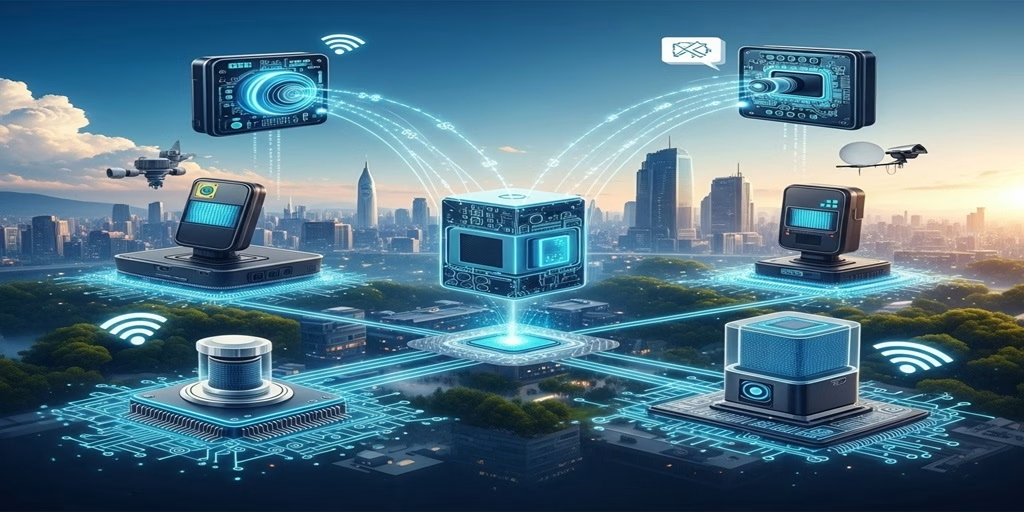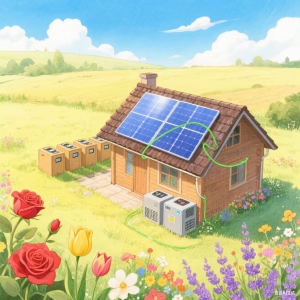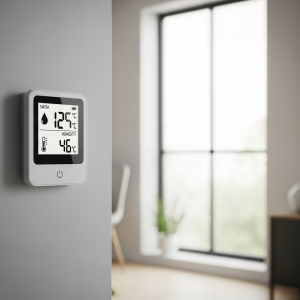Sensor types and how to choose?
Sensor types Introduction
In an increasingly connected world, sensors are the unsung heroes, silently gathering the data that fuels everything from our smartphones to smart cities, autonomous vehicles, and sophisticated industrial automation. They are the “eyes, ears, and touch” of our digital existence, translating the physical world into measurable electrical signals that computers can understand and act upon.But with an explosion of sensor technologies available, navigating the landscape can be daunting. How do you choose the right sensor for your specific application? This comprehensive guide will demystify the world of sensors, exploring their diverse types and providing a step-by-step approach to making informed selection decisions.
What Exactly is a Sensor?
At its core, a sensor is a device that detects and responds to some type of input from the physical environment. The input could be light, heat, motion, moisture, pressure, or any one of a vast number of other environmental phenomena. The output is typically an electrical signal that is proportional to the measured input. This signal can then be processed, analyzed, and used to trigger actions or provide insights.
Think of it this way: a thermometer is a simple sensor that converts temperature (a physical quantity) into a visual reading (a measurable output). Modern electronic sensors do the same, but they convert the physical quantity into an electrical signal that can be easily integrated into digital systems.
A Deep Dive into Sensor Types: The World at Your Fingertips
Sensors can be categorized in numerous ways, but one of the most useful classifications is by the physical quantity they measure. Let’s explore some of the most common and crucial types:
1. Temperature Sensors: Feeling the Heat (or Cold)
Temperature is one of the most frequently measured physical parameters across countless applications, from industrial processes to consumer electronics and medical devices.
Thermocouples:
These robust sensors work on the principle of the Seebeck effect – when two dissimilar metals are joined at two points, a voltage is generated between the junctions if they are at different temperatures. Thermocouples are favored for their wide temperature range and ability to withstand high temperatures, making them ideal for industrial furnaces, engines, and scientific experiments. They are relatively inexpensive but may require external cold-junction compensation for accurate readings.
Thermistors:
These are resistors whose resistance changes significantly with temperature. They come in two main types: Negative Temperature Coefficient (NTC) thermistors, whose resistance decreases as temperature increases, and Positive Temperature Coefficient (PTC) thermistors, whose resistance increases with temperature. NTC thermistors are widely used due to their high sensitivity and fast response time, making them suitable for consumer electronics, automotive applications, and medical devices. However, their temperature range is narrower than thermocouples, and their resistance-temperature relationship is non-linear, requiring linearization.
Resistance Temperature Detectors (RTDs):
RTDs utilize the predictable change in electrical resistance of certain metals (most commonly platinum, hence “Pt100” or “Pt1000”) with temperature. They offer excellent accuracy, stability, and linearity over a wide temperature range compared to thermistors. This makes them perfect for precision applications in laboratories, industrial control, and scientific research, though they are generally more expensive and have slower response times than thermistors.
Temperature Sensor ICs (Integrated Circuits):
These are semiconductor-based sensors that integrate a temperature-sensing element, signal conditioning, and sometimes even an Analog-to-Digital Converter (ADC) onto a single chip. They often provide digital outputs (like I2C, SPI) directly, simplifying integration with microcontrollers. They are compact, low-power, and widely used in consumer electronics, IoT devices, and embedded systems where space and power consumption are critical. Examples include the popular LM35, DS18B20, or various digital temperature sensors from manufacturers like Analog Devices or Maxim Integrated.
2. Pressure Sensors: Sensing Force and Flow
Pressure sensors measure the force exerted by a fluid (liquid or gas) per unit area. They are critical in applications ranging from weather forecasting and automotive systems to medical devices and industrial process control.
Strain Gauge-Based Pressure Sensors:
These are perhaps the most common type. They employ a strain gauge (a resistor whose resistance changes when stretched or compressed) bonded to a diaphragm. As pressure deforms the diaphragm, the strain gauge stretches or compresses, changing its resistance, which is then converted into an electrical signal. They are versatile, robust, and used in a wide array of applications, including industrial process control, automotive tire pressure monitoring, and load cells.
Capacitive Pressure Sensors:
These sensors work by measuring the change in capacitance between two parallel plates, one of which is a flexible diaphragm that deflects under pressure. As the diaphragm moves, the distance between the plates changes, altering the capacitance. They offer high sensitivity, good linearity, and excellent long-term stability, often found in low-pressure applications, medical devices, and HVAC systems.
Piezoresistive Pressure Sensors (MEMS):
Many modern pressure sensors utilize Micro-Electro-Mechanical Systems (MEMS) technology. These tiny sensors integrate the diaphragm and piezoresistors directly onto a silicon chip. They offer compact size, low power consumption, and often integrated signal conditioning, making them ideal for smartphones, wearables, drones, and automotive applications.
Piezoelectric Pressure Sensors:
These sensors leverage the piezoelectric effect, where certain materials (like quartz) generate an electrical charge when subjected to mechanical stress (pressure). They are excellent for measuring dynamic pressure changes, vibrations, and high-frequency phenomena due to their fast response time and ruggedness. They are commonly found in accelerometers, knock sensors, and ultrasonic transducers.
3. Proximity and Displacement Sensors: Knowing Where Things Are
These sensors detect the presence or absence of an object and, in some cases, its distance or position relative to the sensor.
Inductive Proximity Sensors:
These sensors detect the presence of metal objects without physical contact. They work by generating an electromagnetic field; when a metallic object enters this field, eddy currents are induced, which dampens the oscillations and triggers a change in the sensor’s output. They are highly reliable, durable, and unaffected by dirt, dust, or moisture, making them ubiquitous in industrial automation for counting, positioning, and end-of-travel detection.
Capacitive Proximity Sensors:
Unlike inductive sensors, capacitive sensors can detect both metallic and non-metallic objects (liquids, plastics, wood, etc.). They create an electrostatic field; when an object enters this field, it changes the sensor’s capacitance, triggering detection. They are used for level detection, object counting, and sensing through non-metallic barriers.
Photoelectric Sensors (Optical Sensors):
These sensors use light (visible, infrared, or laser) to detect objects. They operate in various modes:
- Through-beam: Emitter and receiver are separate, detecting an object when it breaks the light beam. Highly reliable for long ranges.
- Retro-reflective: Emitter and receiver are in the same housing, and the light reflects off a reflector. An object is detected when it breaks the beam between the sensor and the reflector.
- Diffuse-reflective: Emitter and receiver are in the same housing, and the light reflects directly off the object being detected. Shorter range but flexible. These are versatile and widely used for object detection, counting, presence sensing, and robotic guidance.
Ultrasonic Sensors:
These sensors emit high-frequency sound waves (ultrasound) and measure the time it takes for the waves to return after reflecting off an object (Time-of-Flight principle). They can detect objects regardless of color or transparency and are excellent for measuring distance, level detection, and object detection in challenging environments. Common in parking assist systems, robotics, and industrial tank level monitoring.
Hall Effect Sensors (Magnetic Sensors):
These sensors detect the presence and strength of a magnetic field. When a magnetic field is applied perpendicular to a current-carrying conductor, a voltage (Hall voltage) is generated across the conductor. They are used for position sensing, speed detection (e.g., crankshaft position in automotive), and current sensing.
Encoders:
Encoders are electromechanical devices that convert rotational or linear motion into digital signals.
- Rotary Encoders: Used to measure angular position, speed, and direction of rotation.
- Incremental Encoders: Provide a series of pulses as the shaft rotates, allowing for relative position tracking.
- Absolute Encoders: Provide a unique digital code for each angular position, retaining position even after power loss.
- Linear Encoders: Measure linear displacement. Encoders are crucial in robotics, CNC machines, motor control, and precise positioning systems.
- Rotary Encoders: Used to measure angular position, speed, and direction of rotation.
4. Motion and Inertial Sensors: Understanding Movement
These sensors are fundamental for devices that need to understand their orientation, movement, or acceleration.
Accelerometers:
These devices measure acceleration (the rate of change of velocity) in one or more axes. They typically work on the principle of a mass-spring system, where the displacement of a seismic mass due to acceleration is measured. Accelerometers are used for tilt sensing, vibration detection, impact detection, and in conjunction with gyroscopes for attitude and heading reference systems (AHRS) in drones, smartphones, and wearable tech.
Gyroscopes:
Gyroscopes measure angular velocity (the rate of change of angular position or rotation). MEMS gyroscopes typically use the Coriolis effect to detect rotational motion. Combined with accelerometers, they are essential for determining orientation, stabilizing platforms, navigation, and motion tracking in gaming controllers, virtual reality headsets, and automotive stability control.
PIR (Passive Infrared) Sensors:
These sensors detect infrared radiation emitted by objects (like human bodies). They are “passive” because they don’t emit any energy themselves; they simply detect changes in the ambient infrared patterns. They are widely used for motion detection in security systems, automatic lighting, and smart home applications.
5. Environmental Sensors: Monitoring Our Surroundings
Beyond temperature and humidity, a range of sensors are dedicated to monitoring various aspects of our environment.
Humidity Sensors:
These measure the amount of water vapor in the air.
- Resistive Humidity Sensors: Utilize a material whose electrical resistance changes with humidity.
- Capacitive Humidity Sensors: Employ a material whose dielectric constant changes with humidity, altering its capacitance. Used in HVAC systems, weather stations, smart homes, and industrial drying processes.
Gas Sensors:
These detect the presence and concentration of specific gases in the air. They are vital for safety (detecting combustible gases, carbon monoxide), environmental monitoring (pollution, air quality), and industrial process control. Types include electrochemical, catalytic bead, metal oxide semiconductor (MOS), and infrared gas sensors, each suited for different gas types and concentration ranges.
Light Sensors (Photoresistors, Photodiodes, Phototransistors):
- Photoresistors (LDRs – Light Dependent Resistors): Their resistance decreases as light intensity increases. Simple and inexpensive, used in streetlights, automatic dimmers.
- Photodiodes/Phototransistors: Convert light energy directly into an electrical current. Faster and more precise than LDRs, used in optical communication, remote controls, and light meters.
- Ambient Light Sensors (ALS): Often integrated ICs that provide a digital output proportional to light intensity, common in smartphones and displays for automatic brightness adjustment.
Image Sensors (CCD/CMOS):
These are the heart of digital cameras and machine vision systems. They convert light into electrical signals to capture images. Charge-Coupled Devices (CCDs) are known for high image quality, while Complementary Metal-Oxide-Semiconductor (CMOS) sensors offer lower power consumption, faster readout, and often integrate more functionality on-chip, making them dominant in consumer cameras, smartphones, and many industrial vision applications.
The Crucial Choice: How to Select the Right Sensor
Choosing the perfect sensor is not a trivial task. A wrong choice can lead to inaccurate data, system failures, increased costs, or missed opportunities. Here’s a systematic approach to making an informed decision:
1. Define Your Measurement Needs with Precision
This is the absolute first step. Don’t rush it.
- What physical quantity needs to be measured? (Temperature, pressure, distance, gas concentration, motion, etc.)
- What is the expected range of the measurement? (e.g., -40°C to 125°C, 0-100 psi, 0-5 meters).
- What level of accuracy is required? (e.g., ±0.1°C, ±1%, ±1 mm). What is the acceptable margin of error?
- What is the required resolution? (The smallest change the sensor can detect, e.g., 0.01°C).
- What is the necessary sampling rate or response time? (How quickly does the sensor need to react to changes, and how often do you need a reading?). For real-time control, fast response is paramount.
2. Understand Your Operating Environment
The environment where the sensor will operate significantly impacts its performance and longevity.
- Temperature Range: Will the sensor operate within its specified temperature limits? Extreme temperatures can cause drift or failure.
- Humidity/Moisture: Is the environment wet, humid, or prone to condensation? Consider sensors with appropriate Ingress Protection (IP) ratings (e.g., IP67 for dust-tight and temporary immersion).
- Dust and Particulates: Will dust or dirt interfere with the sensor’s operation (e.g., optical sensors)?
- Vibration and Shock: Will the sensor be subjected to mechanical stress? Choose robust sensors designed for such conditions.
- Electromagnetic Interference (EMI): Are there strong electrical fields, radio frequencies, or other sources of EMI that could affect the sensor’s signal? Shielding or robust communication protocols might be needed.
- Corrosive Substances: Are there chemicals, gases, or liquids that could corrode the sensor material? Specific housing materials or protective coatings might be necessary.
- Lighting Conditions: For optical sensors, consider ambient light, reflections, and potential interference from other light sources.
3. Evaluate Output Signal and Integration Requirements
How will the sensor communicate its data to your control system or microcontroller?
- Analog Output: Voltage (e.g., 0-5V, 0-10V) or current (e.g., 4-20mA). These require an Analog-to-Digital Converter (ADC) for processing by a microcontroller. Current loops (4-20mA) are excellent for long-distance transmission as they are less susceptible to noise.
- Digital Output:
- Serial Protocols: I2C, SPI, UART, Modbus. These are common for direct communication with microcontrollers and offer benefits like reduced wiring and noise immunity.
- Pulse Output: Used by some encoders or flow meters.
- Binary (On/Off): Simple digital signals for presence detection (e.g., limit switches).
- Wireless Communication: Bluetooth, Wi-Fi, LoRa, Zigbee. Essential for remote monitoring and IoT applications, but consider power consumption and range.
4. Consider Power Requirements
- Voltage and Current: Ensure the sensor’s power requirements match your power supply capabilities.
- Power Consumption: For battery-powered devices or energy-harvesting systems, ultra-low power sensors are critical. Some sensors have sleep modes to conserve energy.
5. Assess Physical Constraints and Mounting
- Size and Weight: Is there limited space available for the sensor? Is weight a concern (e.g., drones, wearables)?
- Mounting Options: How will the sensor be physically attached? Does it require specialized brackets or enclosures?
- Accessibility: Will the sensor need to be easily accessible for maintenance or calibration?
6. Factor in Cost – But Not Just the Purchase Price
- Sensor Unit Cost: The immediate price of the sensor itself.
- Installation Cost: Labor, wiring, mounting hardware.
- Integration Cost: Development time for software drivers, calibration procedures.
- Maintenance and Calibration Costs: Regular checks, replacements, recalibration.
- Total Cost of Ownership (TCO): Consider all these factors over the lifetime of the system. A slightly more expensive but highly reliable sensor might save money in the long run by reducing downtime and maintenance.
7. Evaluate Reliability and Lifespan
- Mean Time Between Failures (MTBF): A statistical measure of how long a device is expected to operate before failing.
- Durability: How well can the sensor withstand its operating environment over time?
- Calibration Stability: How often will the sensor need recalibration to maintain accuracy?
- Manufacturer Reputation and Support: Choose reputable manufacturers known for quality and good customer support.
8. Regulatory Compliance
- Industry Standards: Does the sensor need to comply with specific industry standards (e.g., for medical devices, automotive, hazardous locations)?
- Certifications: Does it have necessary certifications (e.g., CE, FCC, UL)?
The Selection Process in Action: A Practical Example
Let’s say you need to develop a smart irrigation system for a garden.
Define Measurement Needs:
- What: Soil moisture content.
- Range: Dry to saturated.
- Accuracy/Resolution: Sufficient to distinguish between dry, moist, and wet conditions to optimize water usage.
- Response Time: A few minutes, not instant.
Understand Environment:
- Temperature: Outdoor temperatures (e.g., -10°C to 40°C).
- Humidity/Moisture: Constantly in wet soil. Requires waterproof/resistant design.
- Dust/Particulates: Soil particles.
- Vibration/Shock: Minimal.
- EMI: Low.
- Corrosive: Soil contains minerals, potentially corrosive over time.
Output Signal: Needs to interface with a microcontroller (Arduino/Raspberry Pi). Analog voltage is common, but digital (I2C/SPI) would simplify wiring.
Power: Battery-powered (solar optional). Low power consumption is critical.
Physical Constraints: Needs to be inserted into soil, durable, relatively small.
Cost: Needs to be affordable for consumer application.
Initial Thoughts & Selection:
- Capacitive Soil Moisture Sensors are often preferred over resistive ones because resistive sensors use bare metal probes that can corrode quickly in soil, leading to inaccurate readings and short lifespans. Capacitive sensors avoid direct electrical contact with the soil, reducing corrosion.
- Look for models with a waterproof coating or robust epoxy encapsulation.
- Many capacitive sensors offer analog voltage output, which is easily read by microcontrollers. Some newer ones might offer digital outputs.
- Low power consumption is key for battery life.
- Cost-effective options are widely available from various suppliers.
By systematically going through these considerations, you’ll narrow down your choices and pick a sensor that truly fits the bill, ensuring reliable and accurate data collection for your application.
The Future of Sensing: Smarter, Smaller, More Connected
The sensor landscape is continuously evolving. We’re seeing trends towards:
- Miniaturization: Thanks to MEMS technology, sensors are getting smaller and smaller, enabling their integration into ever more compact devices.
- Integration: More sensors are being combined onto a single chip (e.g., IMUs combining accelerometers and gyroscopes) or with integrated signal processing, microcontrollers, and communication modules.
- Intelligence: “Smart sensors” incorporate on-board processing capabilities, allowing them to perform local data analysis, calibration, and even make decisions before transmitting data, reducing bandwidth and power consumption.
- Wireless Connectivity: The rise of IoT is driving the demand for low-power, long-range wireless sensors that can form vast networks.
- New Sensing Modalities: Research continues into novel ways of sensing, including bio-sensors, chemical sensors, and quantum sensors, opening up new possibilities for healthcare, environmental monitoring, and fundamental research.
Conclusion
Sensors are the backbone of the digital age, enabling machines to perceive and interact with the physical world. Understanding the diverse types available and having a systematic approach to selection is paramount for engineers, hobbyists, and innovators alike. By meticulously defining your needs, considering the operating environment, evaluating technical specifications, and factoring in practical considerations like cost and reliability, you can unlock the full potential of sensor technology and bring your intelligent systems to life. The right sensor isn’t just a component; it’s the critical link between the tangible and the digital, empowering us to build a more responsive, efficient, and intelligent future.





